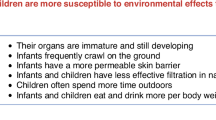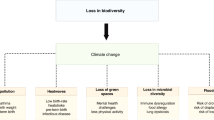Impact
-
This article summarizes the adverse effects of climate and environmental change on children’s health.
-
We call for policy change, education, and advocacy to halt further deterioration of planetary health and for specific measures to prevent the negative effects of climate and environmental change on children’s health.
-
We offer an agenda for research, policy change, and healthcare practices to improve the resilience of pediatric populations in the face of climate change.
Similar content being viewed by others
Log in or create a free account to read this content
Gain free access to this article, as well as selected content from this journal and more on nature.com
or
References
Our world in data. Global Fossil Fuel Consumption https://ourworldindata.org/fossil-fuels (2022).
Climate.gov. Climate Change: Atmospheric Carbon Dioxide https://www.climate.gov/news-features/understanding-climate/climate-change-atmospheric-carbon-dioxide (2022).
IPCC. Climate Change Widespread, Rapid, and Intensifying – IPCC https://www.ipcc.ch/2021/08/09/ar6-wg1-20210809-pr/ (2021).
Trancoso, R. et al. Heatwaves intensification in Australia: a consistent trajectory across past, present and future. Sci. Total Environ. 742, 140521 (2020).
Vargo, L. J. et al. Anthropogenic warming forces extreme annual glacier mass loss. Nat. Clim. Change 10, 856–861 (2020).
Liu, Y., Goodrick, S. L. & Stanturf, J. A. Future U.S. wildfire potential trends projected using a dynamically downscaled climate change scenario. For. Ecol. Manag. 294, 120–135 (2013).
Perkins-Kirkpatrick, S. E. & Lewis, S. C. Increasing trends in regional heatwaves. Nat. Commun. 11, 3357 (2020).
Romanello, M. et al. The 2021 report of the Lancet countdown on health and climate change: code red for a healthy future. Lancet 398, 1619–1662 (2021).
National Oceanic and Atmospheric Administration. Ocean Acidification https://www.noaa.gov/education/resource-collections/ocean-coasts/ocean-acidification (2020).
Mazdiyasni, O. et al. Increasing probability of mortality during indian heat waves. Sci. Adv. 3, e1700066 (2017).
EPA. Estimate of Pollutant Emissions from Fires in the Wildland Urban Interface https://cfpub.epa.gov/si/si_public_record_report.cfm?dirEntryId=349539&Lab=CEMM (2020).
Mukherjee, A. & Agrawal, M. A global perspective of fine particulate matter pollution and its health effects. Rev. Environ. Contam Toxicol. 244, 5–51 (2018).
D’Amato, G. et al. The effects of climate change on respiratory allergy and asthma induced by pollen and mold allergens. Allergy 75, 2219–2228 (2020).
Harun, N. S., Lachapelle, P. & Douglass, J. Thunderstorm-triggered asthma: what we know so far. J. Asthma Allergy 12, 101–108 (2019).
Semenza, J. C. & Suk, J. E. Vector-borne diseases and climate change: a European perspective. FEMS Microbiol. Lett. 365, fnx244 (2018).
Agache, I. et al. Climate change and global health: a call to more research and more action. Allergy 77, 1389–1407 (2022).
UNHCR, The UN Refugee Agency. Global Trends: Forced Displacement in 2018 https://www.unhcr.org/globaltrends2018/ (2018).
Eurostat. Statistics Explained. Chemicals Production and Consumption Statistics https://ec.europa.eu/eurostat/statistics-explained/index.php?title=Chemicals_production_and_consumption_statistics#Total_production_of_chemicals (2021).
World Health Organization. More Than 90% of the World’s Children Breathe Toxic Air Every Day https://www.who.int/news/item/29-10-2018-more-than-90-of-the-worlds-children-breathe-toxic-air-every-day (2018).
Wright, S. L. & Kelly, F. J. Plastic and human health: a micro issue? Environ. Sci. Technol. 51, 6634–6647 (2017).
Perera, F. & Nadeau, K. Climate change, fossil-fuel pollution, and children’s health. N. Engl. J. Med. 386, 2303–2314 (2022).
UNICEF. The Climate Crisis Is a Child Rights Crisis https://www.unicef.org/media/105376/file/UNICEF-climate-crisis-child-rights-crisis.pdf (2021).
Sheffield, P. E. & Landrigan, P. J. Global climate change and children’s health: threats and strategies for prevention. Environ. Health Perspect. 119, 291–298 (2011).
Li, X. et al. Association between ambient fine particulate matter and preterm birth or term low birth weight: an updated systematic review and meta-analysis. Environ. Pollut. 227, 596–605 (2017).
Ozonoff, A. et al. Phenotypes of disease severity in a cohort of hospitalized COVID-19 patients: results from the IMPACC study. eBioMedicine 83, 104208 (2022).
Abraham, E. et al. Pregnancy exposure to atmospheric pollution and meteorological conditions and placental DNA methylation. Environ. Int. 118, 334–347 (2018).
Liu, P. R. & Raftery, A. E. Country-based rate of emissions reductions should increase by 80% beyond nationally determined contributions to meet the 2 °C target. Commun. Earth Environ. 2, 29 (2021).
World Health Organization. Cop26 Special Report on Climate Change and Health: The Health Argument for Climate Action https://www.who.int/publications/i/item/9789240036727 (2021).
Funding
Financial support was provided by the Sean N. Parker Center for Allergy and Asthma Research at Stanford University, NHLBI grant P01HL152953, and NIEHS grant R01ES032253.
Author information
Authors and Affiliations
Contributions
All authors contributed to the writing and review of the manuscript.
Corresponding author
Ethics declarations
Competing interests
The authors declare no competing interests.
Additional information
Publisher’s note Springer Nature remains neutral with regard to jurisdictional claims in published maps and institutional affiliations.
Rights and permissions
Springer Nature or its licensor (e.g. a society or other partner) holds exclusive rights to this article under a publishing agreement with the author(s) or other rightsholder(s); author self-archiving of the accepted manuscript version of this article is solely governed by the terms of such publishing agreement and applicable law.
About this article
Cite this article
Sampath, V., Nadeau, K.C., Ebi, K.L. et al. Improving planetary health is integral to improving children’s health—a call to action. Pediatr Res (2022). https://doi.org/10.1038/s41390-022-02432-x
Received:
Revised:
Accepted:
Published:
DOI: https://doi.org/10.1038/s41390-022-02432-x



